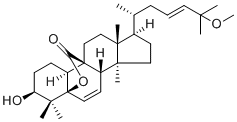25-O-Methylkaravilagenin DCAS# 1363422-85-8 |

Quality Control & MSDS
Package In Stock
Number of papers citing our products

| Cas No. | 1363422-85-8 | SDF | Download SDF |
| PubChem ID | N/A | Appearance | Powder |
| Formula | C31H48O4 | M.Wt | 484.7 |
| Type of Compound | Triterpenoids | Storage | Desiccate at -20°C |
| Solubility | Soluble in Chloroform,Dichloromethane,Ethyl Acetate,DMSO,Acetone,etc. | ||
| General tips | For obtaining a higher solubility , please warm the tube at 37 ℃ and shake it in the ultrasonic bath for a while.Stock solution can be stored below -20℃ for several months. We recommend that you prepare and use the solution on the same day. However, if the test schedule requires, the stock solutions can be prepared in advance, and the stock solution must be sealed and stored below -20℃. In general, the stock solution can be kept for several months. Before use, we recommend that you leave the vial at room temperature for at least an hour before opening it. |
||
| About Packaging | 1. The packaging of the product may be reversed during transportation, cause the high purity compounds to adhere to the neck or cap of the vial.Take the vail out of its packaging and shake gently until the compounds fall to the bottom of the vial. 2. For liquid products, please centrifuge at 500xg to gather the liquid to the bottom of the vial. 3. Try to avoid loss or contamination during the experiment. |
||
| Shipping Condition | Packaging according to customer requirements(5mg, 10mg, 20mg and more). Ship via FedEx, DHL, UPS, EMS or other couriers with RT, or blue ice upon request. | ||

25-O-Methylkaravilagenin D Dilution Calculator

25-O-Methylkaravilagenin D Molarity Calculator
| 1 mg | 5 mg | 10 mg | 20 mg | 25 mg | |
| 1 mM | 2.0631 mL | 10.3157 mL | 20.6313 mL | 41.2626 mL | 51.5783 mL |
| 5 mM | 0.4126 mL | 2.0631 mL | 4.1263 mL | 8.2525 mL | 10.3157 mL |
| 10 mM | 0.2063 mL | 1.0316 mL | 2.0631 mL | 4.1263 mL | 5.1578 mL |
| 50 mM | 0.0413 mL | 0.2063 mL | 0.4126 mL | 0.8253 mL | 1.0316 mL |
| 100 mM | 0.0206 mL | 0.1032 mL | 0.2063 mL | 0.4126 mL | 0.5158 mL |
| * Note: If you are in the process of experiment, it's necessary to make the dilution ratios of the samples. The dilution data above is only for reference. Normally, it's can get a better solubility within lower of Concentrations. | |||||

Calcutta University

University of Minnesota

University of Maryland School of Medicine

University of Illinois at Chicago

The Ohio State University

University of Zurich

Harvard University

Colorado State University

Auburn University

Yale University

Worcester Polytechnic Institute

Washington State University

Stanford University

University of Leipzig

Universidade da Beira Interior

The Institute of Cancer Research

Heidelberg University

University of Amsterdam

University of Auckland

TsingHua University

The University of Michigan

Miami University

DRURY University

Jilin University

Fudan University

Wuhan University

Sun Yat-sen University

Universite de Paris

Deemed University

Auckland University

The University of Tokyo

Korea University
- Saikochromone A
Catalog No.:BCN0589
CAS No.:132624-99-8
- Taikuguasin D aglycon
Catalog No.:BCN0588
CAS No.:2185847-09-8
- 3,5,7-Trihydroxychromone 3-O-β-D-xylopyranoside
Catalog No.:BCN0587
CAS No.:916204-15-4
- Neochlorogenin 6-O-β-D-quinovopyranoside
Catalog No.:BCN0586
CAS No.:711025-86-4
- Embinin
Catalog No.:BCN0585
CAS No.:52589-13-6
- Curvularin
Catalog No.:BCN0584
CAS No.:10140-70-2
- (19S,23S)-5β,19-Epoxy-19,23-dimethoxycucurbita-6,24-dien-3β-ol
Catalog No.:BCN0583
CAS No.:1616120-83-2
- Torvoside D
Catalog No.:BCN0582
CAS No.:20735-79-9
- 25-Epitorvoside D
Catalog No.:BCN0581
CAS No.:1306729-49-6
- Abscisic acid β-D-glucopyranosyl ester
Catalog No.:BCN0580
CAS No.:21414-42-6
- 7α-O-Methylmorroniside
Catalog No.:BCN0579
CAS No.:119943-45-2
- Neochlorogenin 6-O-β-D-xylopyranosyl-(1→3)-β-D-quinovopyranoside
Catalog No.:BCN0578
CAS No.:184686-02-0
- Karaviloside VIII
Catalog No.:BCN0591
CAS No.:934739-32-9
- (19R)-5β,19-Epoxy-19-methoxycucurbita-6,23-diene-3β,25-diol
Catalog No.:BCN0592
CAS No.:332950-28-4
- Solagenin 6-O-β-D-quinovopyranoside
Catalog No.:BCN0593
CAS No.:184686-03-1
- 3β,7β,19-Trihydroxy-25-methoxycucurbita-5,23-diene 7-O-glucoside
Catalog No.:BCN0594
CAS No.:81910-37-4
- 8-[(6,7-Dihydroxy-3,7-dimethyloct-2-en-1-yl)oxy]psoralen
Catalog No.:BCN0595
CAS No.:889112-17-8
- 3β,7β-Dihydroxy-25-methoxycucurbita-5,23-dien-19-al
Catalog No.:BCN0596
CAS No.:132587-67-8
- 3-Hydroxy-4-methoxybenzyl alcohol
Catalog No.:BCN0597
CAS No.:4383-06-6
- 11β,13-Dihydrotaraxinic acid β-D-glucopyranosyl ester
Catalog No.:BCN0598
CAS No.:75911-16-9
- Taraxinic acid β-D-glucopyranosyl ester
Catalog No.:BCN0599
CAS No.:75911-14-7
- cis-Vitisin B
Catalog No.:BCN0600
CAS No.:142507-86-6
- 3,7,8-Tri-O-methylellagic acid 2-O-rutinoside
Catalog No.:BCN0601
CAS No.:56470-18-9
- 7-Hydroxy-1-methoxy-3-methylcarbazole
Catalog No.:BCN0602
CAS No.:107672-54-8
Cucurbitane triterpenoids from the leaves of Momordica charantia, and their cancer chemopreventive effects and cytotoxicities.[Pubmed:22344919]
Chem Biodivers. 2012 Feb;9(2):428-40.
Seventeen cucurbitane-type triterpenoids, 1-17, including six new compounds, (23E)-3beta,25-dihydroxy-7beta-methoxycucurbita-5,23-dien-19-al (1), (23S*)-3beta-hydroxy-7beta,23-dimethoxycucurbita-5,24-dien-19-al (6), (23R*)-23-O-methylmomordicine IV (7), (25xi)-26-hydroxymomordicoside L (8), 25-oxo-27-normomordicoside L (9), and 25-O-Methylkaravilagenin D (12), were isolated from a MeOH extract of the leaves of Japanese Momordica charantia. The structures of new compounds were elucidated on the basis of extensive spectroscopic analyses and comparison with literature. Compounds 1-17 were examined for their inhibitory effects on Epstein-Barr virus early antigen (EBV-EA) activation induced with 12-O-tetradecanoylphorbol-13-acetate (TPA) in Raji cells, a known primary screening test for inhibitors of tumor promotion. Four compounds, 1, (23E)-3beta,7beta-dihydroxy-25-methoxycucurbita-5,23-dien-19-al (2), karavilagenin D (11), and 12, showed potent inhibitory effects on EBV-EA induction with IC(50) values in the range of 242-264 mol ratio/32 pmol TPA. In addition, compounds 1 and 11 exhibited inhibitory effects on skin-tumor promotion in an in vivo two-stage mouse skin carcinogenesis test based on 7,12-dimethylbenz[a]anthracene (DMBA) as initiator, and with TPA as a promoter. Furthermore, upon evaluation of the cytotoxic activities of compounds 1-17 against human cancer cell lines, compounds 2, 5-7, 9, and 14 showed potent activities against HL60 cell line, and compound 2 against SK-BR-3 cell line.


